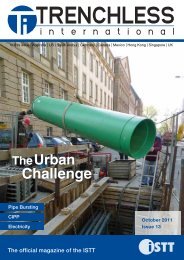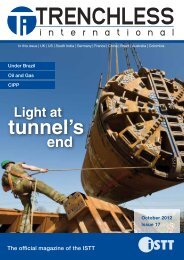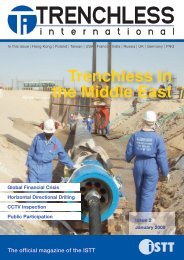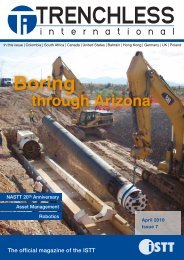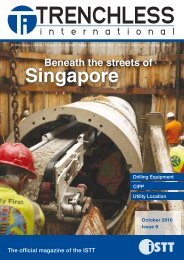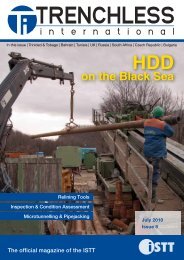North American Special - Trenchless International
North American Special - Trenchless International
North American Special - Trenchless International
Create successful ePaper yourself
Turn your PDF publications into a flip-book with our unique Google optimized e-Paper software.
Record SWP down under<br />
Interflow, an Australian pipeline renewal contractor, recently installed the world’s longest and largest<br />
continuous spirally wound pipe liner from a fixed winding machine as part of a sewer rehabilitation<br />
project in Sydney.<br />
PIPE AND conduit<br />
April 2009 - <strong>Trenchless</strong> <strong>International</strong><br />
High-density polyethylene (HDPE)<br />
<strong>Trenchless</strong> applications: HDD, pipe bursting, microtunnelling, sliplining<br />
Best suited for: water and wastewater, natural gas, fibre optics<br />
Paul Hogan and Robert Banks discovered crystalline polypropylene, and a similar<br />
plastic that could be produced using ethylene in 1931. When Hogan and Banks<br />
first created a reaction between ethylene and benzaldehyde using two thousand<br />
atmospheres of internal pressure, their experiment went askew when all the pressure<br />
escaped due to a leak in the testing container. On opening the tube they found<br />
a white waxy substance that looked a lot like some form of plastic.<br />
After repeating the experiment, they discovered that the loss of pressure was<br />
not due to a leak at all, but was a result of the polymerisation process. The residue<br />
polyethylene resin was a milky white, translucent substance derived from ethylene<br />
(CH2=CH2). Polyethylene was produced with either a low or high density. Highdensity<br />
polyethylene was developed in 1951.<br />
HDPE is flexible, tough, lightweight and impact resistant for lower cost installation.<br />
HDPE has performed well during earthquakes, tsunamis and corrosive environments.<br />
HDPE can be either fused or mechanically joined and is commonly available<br />
in diameters 15 to 160 mm.<br />
The life span of HDPE pipes is up to 100 years depending on design requirements<br />
and water quality.<br />
Polymer concrete pipe<br />
<strong>Trenchless</strong> applications: microtunnelling,<br />
pipe jacking<br />
Best suited for: waste water<br />
Polymer concrete is similar to conventional<br />
concrete in that it contains selected<br />
blends of aggregates and fillers that are<br />
held together using a binder. In polymer<br />
concrete the binder is high strength, corrosion<br />
resistant, thermosetting resin. This<br />
resin requires a curing agent which, when<br />
combined with the resin, transfers the<br />
resin and curing agent from a liquid to a<br />
solid that bonds the aggregate, various<br />
fillers and internal reinforcement.<br />
Advantages of polymer concrete include<br />
rapid curing at ambient temperatures,<br />
good adhesion to most surfaces, good<br />
long term durability with respect to freeze<br />
and thaw cycles, good chemical resistance,<br />
lightweight and high tensile and<br />
flexural.<br />
The standard joint for tunnelling and<br />
jacking installations incorporates a pushon<br />
stainless steel collar in common<br />
diameters of 200 up to 2,600 mm.<br />
F i b r e g l a s s reinforced pipe<br />
<strong>Trenchless</strong> applications: microtunnelling,<br />
jacking, slipling, tunnel lining<br />
and casings<br />
Best suited for: water, waste water,<br />
irrigation and drainage<br />
Fibreglass reinforced thermosetting<br />
plastic (‘fibreglass’) first became a<br />
viable alternative to protected steel,<br />
stainless steel and exotic materials<br />
in 1950. That year, centrifugal cast<br />
fibreglass piping was first used in<br />
the crude oil production industry as a<br />
solution to corrosion problems. It was<br />
during the 1960s that manufacturers<br />
began to develop nationally recognised<br />
standards and test methods<br />
for fibreglass storage and fibreglass<br />
piping systems.<br />
Fibreglass piping contains glass<br />
fibre reinforcement embedded in<br />
cured thermosetting resin. This composite<br />
structure typically contains<br />
additives such as pigments and dyes.<br />
By selecting the proper combination<br />
of resin, glass fibres, additives and<br />
design, the fabricator can create a<br />
product that meets the equipment<br />
designer’s performance standard.<br />
Fibreglass pipe is joined with pushtogether;<br />
gasket-sealed joints in<br />
common diameters of 450 up to 3,000<br />
mm with larger diameters possible.<br />
The design life is in excess of fifty<br />
years.<br />
This article is intended as a guide only; we recommended readers seek appropriate advice before selecting<br />
pipe material. This article was compiled with information from: <strong>American</strong> SpiralWeld pipe (www.acipco.<br />
com/aswp), Oxford Plastics Inc. (www.oxfordplasticsinc.com), Plastic, Pipes and Fitting Association (www.<br />
ppfahome.org), <strong>American</strong> Iron and Steel Institute (www.steel.org//AM), Fibreglass tank and pipe (www.<br />
fiberglasstankandpipe.com), Uni-Bell PVC Pipe Association (www.uni-bell.org), Plastic Industry and Pipe<br />
Association www.pipa.com.au, <strong>American</strong> Concrete Pipe Association (www.concrete-pipe.org), Ductile Iron<br />
Pipe Research Association (www.dipra.co),<br />
Hobas Pipe (www.hobas.com), National Association of Steel Pipe Distributers Association (www.naspd.com)<br />
and the National Clay Pipe Institute (www.ncpi.org).<br />
The pipe liner was 633 metres long,<br />
the equivalent of more than six football<br />
fields in length, 2.4 metres in diameter, and<br />
weighed almost 100 tonnes.<br />
The previous record for the longest continuous<br />
spirally wound pipe liner installed<br />
from a stationary winding machine was 340<br />
metres of an 800 mm diameter pipe liner.<br />
The installation method used by Interflow<br />
involved producing an in-situ pipe by spirally<br />
winding a composite plastic strip at a<br />
fixed diameter within the host pipe.<br />
The pipe liner was formed by feeding a<br />
profiled composite strip into a hydraulically<br />
powered winding machine positioned inside<br />
the existing access chamber. Adjacent profile<br />
strips were extrusion welded together<br />
inside the winding machine to form a high<br />
strength, water-tight pipe. As more strip<br />
was fed into the machine, the newly formed<br />
pipe corkscrewed its way to the downstream<br />
access chamber. The total length<br />
of 633 metres was achieved over a period<br />
of several days.<br />
Spirally winding pipes and pipe liners is<br />
not new. Various systems and techniques<br />
have existed for decades. Up until this<br />
point the practical limitation for the maximum<br />
length and size of pipe that could<br />
be produced was governed by the torque<br />
of the winding machine and its ability<br />
to overcome the frictional forces of the<br />
newly wound pipe as it rotates inside the<br />
host pipe. In the last few years, Interflow<br />
has perfected a technique for reducing<br />
the frictional forces by floating the newly<br />
formed pipe while being wound. In doing<br />
this, Interflow is able to use the flow inside<br />
the pipe to its benefit and obtain the added<br />
bonus of not needing to bypass the sewer<br />
in the act of renewal. Interflow’s technique<br />
involves controlling the water levels inside<br />
and outside the liner to achieve optimum<br />
buoyancy. In performing this work there<br />
was no indication that 633 metres was the<br />
limit of the technology. Based on the performance<br />
of the machine and the torque<br />
readings, Interflow has its sights firmly set<br />
on breaking through the one kilometre barrier<br />
in the future.<br />
This record installation by Interflow is<br />
a significant innovation for the trenchless<br />
sewer renewal industry not only because<br />
of the feat itself but also for the fact that<br />
it has opened up the potential for making<br />
very long pipelines from a single location,<br />
whether for pipe relining or tunnel boring or<br />
any other similar application. Interflow has<br />
plans to build on this platform and explore<br />
further opportunities.<br />
In this particular project, installing a pipe<br />
liner at this diameter and this length was<br />
essential because the distance between<br />
successive access chambers was uncharacteristically<br />
long. In a sense there were<br />
few other options available to reline the<br />
pipe, demonstrating once more that the<br />
<strong>Trenchless</strong> Technology industry continues<br />
to respond to the ever increasing challenges<br />
that the asset owners put to the<br />
market.<br />
The installation method, as more profile<br />
is fed into the winding machine the pipe<br />
travels towards the downstream access<br />
chamber. By the time it reached its destination<br />
100 tonnes of pipe was all turning at<br />
once.<br />
The Project<br />
The NGRS pipeline is a 2.515 metre<br />
diameter concrete sewer that runs from<br />
the Sydney suburbs of Landsdowne in<br />
the West to Arncliffe in the East. It was<br />
constructed in the 1950s and in some<br />
parts was gas attacked and in need of<br />
rehabilitation. The major challenges for<br />
Interflow were firstly to provide a structural<br />
pipe liner at such a large diameter<br />
and secondly to install a liner from existing<br />
access chambers and in continuous<br />
lengths between access chambers.<br />
In the trenchless sewer rehabilitation<br />
market, where the majority of pipe diameters<br />
are less than 1 metre, the most<br />
commonly used pipe products are made<br />
from plastic or resins. At these diameters<br />
plastic can provide a cost effective<br />
pipe, stiff enough to resist the applied<br />
loads. However, as pipe sizes increase<br />
beyond 1 metre in diameter, the range of<br />
plastic products that can provide a pipe<br />
stiff enough to resist the applied loads<br />
diminish, making it increasingly difficult<br />
to provide a practical and cost-effective<br />
liner.<br />
Interflow’s product of choice for these<br />
large diameter projects is RiblineTM, a<br />
unique steel reinforced spirally wound<br />
high density polyethylene liner. Ribline<br />
was developed by Rib Loc in 2005. A<br />
major advantage of Ribline is that the<br />
composite action between the steel and<br />
the plastic produces a pipe liner with a<br />
high strength to weight ratio and gives<br />
both the strength of steel and durability<br />
of polyethylene. For this application the<br />
Ribline pipe liner was designed to the<br />
required stiffness by using a specific size<br />
of steel reinforcement inside the plastic<br />
ribs of the profile that forms the liner.<br />
This allowed Interflow to offer its client<br />
a strong pipe with a minimum loss of<br />
cross sectional area. In fact the hydraulic<br />
performance of the lined pipe is actually<br />
enhanced as a result of relining.<br />
To put the strength to weight ratio of<br />
Ribline into perspective, a 1 metre long<br />
section of liner at 2.4 metre in diameter<br />
weighed only 150 kg. An equivalent<br />
concrete jacking pipe at the same diameter<br />
and the same strength would have<br />
weighed almost 3,000 kg.<br />
The steps involved in renewing the pipe<br />
include the following. Firstly the existing<br />
pipe and conduit<br />
April 2009 - <strong>Trenchless</strong> <strong>International</strong><br />
48<br />
49






